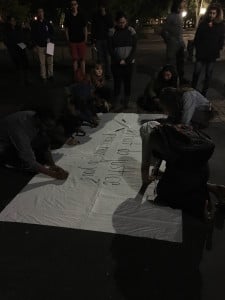
Gathered in the midst of White Plaza on Wednesday evening, an interfaith group that included Jewish, Muslim and Catholic students stood together mourning the lives lost to the recent violence in Israel and the West Bank.
Students collected around a banner reading “What does justice and peace mean to you?” in a moment of silence as the vigil began. Simone Hudson ’17, a member of Stanford’s Jewish community and a primary organizer of the vigil, began by explaining the event’s purpose.
“[We want to] call for an end to violence and unequivocally condemn the violence that has occurred, call out the roots of that violence and our own complicity in that violence,” Hudson said. “To mourn lives lost and recognize the humanity of every single person who has perished.”
Although the speakers varied in their tones and methods of expressing solace, the common theme of appreciating humanity permeated throughout the vigil. Members of the Jewish community from many different groups spoke alongside members of the Muslim Student Union (MSU) and the Catholic Community.
Ben Limonchik ’17 spoke first, telling the other attendees about the process he undertakes whenever a life is lost in his hometown of Jerusalem, sifting through the news in fear that the names released are friends or family. On Oct. 13, he saw the name of Richard Lakin, his old English teacher.
“As a person who knew [Richard], he was such a devoted person to the education of the kids he taught,” Limonchik said. “Ironically enough, Richard was a member of an organization…that brings together Jews and Muslims and Christians…to sit down and discuss their differences.”
Another student, David Kahn ’17, spoke of the underlying societal causes of violence like the mistrust and hostility stemming from Israeli occupation and Palestinian legitimization of terror. He left the group with a challenge.
“How can I learn to appreciate and respect the differing perspectives of my peers while still staying true to my personal beliefs and values?” he asked.
The use of this self-actualizing, introspective call to action was common among other speakers. Although students within and between faiths held a wide range of opinions, most who were there agreed that non-violent action is the best way of moving towards peace.
The MSU recited a verse from the Quran and a prayer expressing the importance of gathering together “to speak for justice,” according to Soumeya Kerrar ’17, co-president of MSU.
Representing the Catholic Community, Matthew Gonzalez ’16 continued the multifaith spirit and greeted the group with the Arabic, Hebrew and English words “salaam alaykum, shalom aleichem, peace be with you.”
This peaceful ethos carried on to the end of the memorial when all in attendance wrote down their interpretations of peace and justice, filling the center white banner with multifarious opinions. Representing the spectrum of opinions were phrases like “self-determination for all people,” “open hearts, open minds, one love” and “what we want to leave for our children.”
“I think there’s incredible power to [people of all faiths] coming together to hold our common values of the inherent dignity of all people,” Hudson said. “When we come together from an interfaith perspective to honor the dignity of all people, we send a powerful message.”
In order to embody this message, the organizers of the vigil wanted it to serve as a forum for all voices, regardless of political or religious background.
“By no means do we want to present this as a monolithic set of goals or political views,” Hudson said. “Actually, there’s a lot of diversity in our group.”
Although there remains a long way to go to peace, Hudson believes Stanford students can play active roles in ameliorating the conflict.
“We need to work to continuously build bridges in our community without silencing the diversity of views,” Hudson said. “Harness our collective power while also honoring the very different approaches that people might have.”
Contact Yael Lederman at yael3 ‘at’ stanford.edu.
This post has been updated. A previous version referenced Soumeya Kerrar as the financial officer of MSU and a member of the class of ’18. She is the co-president of MSU and is a member of the class of ’17. The Daily regrets this error.
